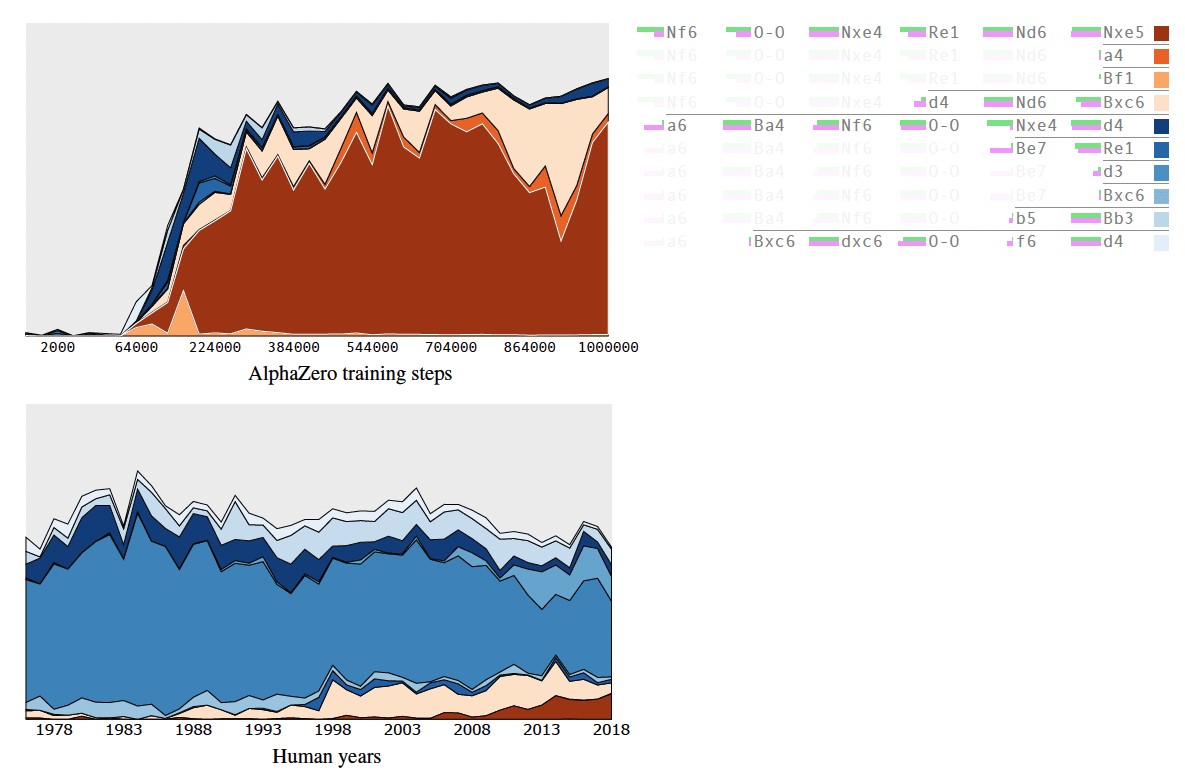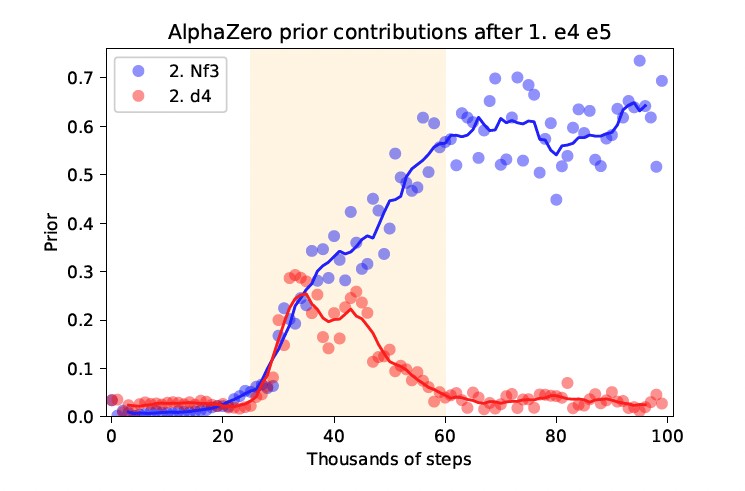How Did Alphazero Learn Chess? AlphaZero mastered chess through self-play, rapidly developing an understanding of the game that rivals and, in some ways, surpasses human comprehension, and at LEARNS.EDU.VN, we delve deep into AI learning processes to help you understand complex topics easily. Explore AI’s strategies and enhance your knowledge with insights on material evaluation and strategic thinking.
1. Understanding AlphaZero’s Chess Learning Foundation
AlphaZero’s groundbreaking approach to learning chess involves a process that mirrors and diverges from human learning methods. This involves a deep dive into how AlphaZero encodes human conceptual knowledge, evaluates piece value, and contrasts its learning progression with historical human chess knowledge. Understanding these aspects provides a comprehensive view of AlphaZero’s mastery of chess.
1.1. How Does AlphaZero Encode Human Conceptual Knowledge?
AlphaZero’s approach to encoding human conceptual knowledge involves using pre-specified functions to encapsulate domain-specific knowledge such as bishop pairs, material balance, mobility, and king safety. Researchers at DeepMind developed a method to encode human conceptual knowledge to determine how well AlphaZero’s network understands chess concepts. They used concepts from Stockfish 8’s evaluation function, including material, imbalance, mobility, king safety, threats, passed pawns, and space. These are sub-functions that provide individual scores, which lead to a total evaluation.
The third type of concept included more specific, lower-level features such as forks, pins, contested files, and pawn structure characteristics. To locate these human concepts within the AlphaZero network, researchers used a sparse linear regression model. Following this, they visualized the concept learning using what-when-where plots, which show what concept is learned, when it is learned during training, and where it is located within the network. This meticulous approach allows AlphaZero to discern and apply these concepts in its gameplay, reflecting an understanding that aligns with human strategic thinking.
1.2. How Does AlphaZero Evaluate Piece Value and Material?
One of the primary concepts AlphaZero needs to understand is the value of each piece, which is a basic lesson for any beginner chess player. Traditional values assign nine points to the queen, five to the rook, three to the bishop and knight, and one to the pawn. During its training, AlphaZero’s piece weights converged towards these commonly accepted values, as shown in the image below:
Researchers found that material became increasingly important early in training, consistent with human learning, until it plateaued. Subsequently, more nuanced concepts like mobility and king safety gained importance while material considerations decreased. This indicates that AlphaZero, like skilled human players, learns to appreciate deeper strategic elements beyond mere material advantage.
1.3. How Does AlphaZero’s Training Compare to Human Chess Knowledge Over History?
A notable difference exists between how AlphaZero and humans progress in their understanding of chess openings. AlphaZero begins with a uniform opening book, exploring all options equally, and gradually narrows down plausible choices over time.
Historical human chess games show the opposite pattern, starting with a strong preference for 1.e4, followed by a gradual expansion of plausible options over the centuries. Researchers compared AlphaZero’s self-play games with a vast database of human games dating from 1475 to the 21st century.
Humans initially favored 1.e4 almost exclusively, while 1.d4 gained popularity in the early 20th century, followed by more flexible systems like 1.c4 and 1.Nf3. Conversely, AlphaZero explores a wide range of opening moves early in its training before valuing the “main” moves more highly.
2. Decoding AlphaZero’s Learning Techniques
To further understand AlphaZero’s learning process, it’s essential to break down specific techniques such as its approach to the Berlin Ruy Lopez, its opening move preferences, and qualitative assessments from chess experts like Vladimir Kramnik. These analyses provide a detailed view of how AlphaZero evolves its strategies and decision-making skills.
2.1. What Can We Learn from AlphaZero’s Approach to the Berlin Ruy Lopez?
The Berlin variation of the Ruy Lopez (1.e4 e5 2.Nf3 Nc6 3.Bb5 Nf6) gained popularity at the top level in the early 21st century, after Vladimir Kramnik used it in his 2000 World Championship match against Garry Kasparov. Before this, it was considered passive, with 3…a6 being the preferred move.
Researchers noted that human chess opening theory took time to fully appreciate the Berlin Defence’s benefits and develop effective strategies for Black. AlphaZero, however, quickly developed a preference for this line of play upon mastering basic game concepts, highlighting a difference in opening play evolution between humans and machines.
Interestingly, when different versions of AlphaZero were trained from scratch, half preferred 3… a6, while the other half preferred 3… Nf6, showing no single “correct” way to play. This indicates that AlphaZero independently rediscovers and validates complex strategic options, sometimes diverging from established human preferences.
2.2. How Does AlphaZero Develop its Opening Move Preferences?
AlphaZero develops its own opening “theory” for a wide range of openings over its training. It identifies 1.d4 and 1.e4 as strong opening moves and rapidly adopts them. Similarly, AlphaZero quickly determines its preferred continuation after 1.e4 e5. The system quickly learns 2.d4 and 2.Nf3 as reasonable moves for White, but then drops 2.d4 in favor of 2.Nf3 as the standard reply. This shows that AlphaZero refines its understanding of opening principles through extensive self-play, discovering and validating effective strategies in a way that mirrors human theoretical development but at an accelerated pace.
2.3. What Qualitative Assessments Did Vladimir Kramnik Provide on AlphaZero’s Play?
Vladimir Kramnik provided qualitative assessments of AlphaZero’s play at different training stages. In early training, AlphaZero showed a crude understanding of material value and struggled to accurately assess material in complex positions, leading to undesirable exchanges and material losses. By the second stage, AlphaZero had a solid grasp of material value and could capitalize on the earlier version’s weaknesses.
In the third stage, Kramnik observed that AlphaZero better understood king safety in imbalanced positions. The second version underestimated attacks and long-term sacrifices, while overestimating its own attacks, leading to losing positions. By the fourth stage, AlphaZero had a much deeper understanding of successful and unsuccessful attacks. It sometimes accepted sacrifices from the third version, defended well, maintained its material advantage, and converted it into a win. Kramnik also noted that tactical skills seemed to precede positional skills in AlphaZero’s learning, similar to human chess learning.
3. Analyzing the Broader Implications of AlphaZero’s Learning
The implications of AlphaZero’s learning extend beyond chess, touching on broader applications in artificial intelligence and human understanding. By examining the impact outside of chess, the discovery of human-understandable concepts, and the perspectives of researchers, we can appreciate the potential of AI to transform various fields.
3.1. What Are the Implications Outside of Chess?
The insights gained from AlphaZero’s training have significant implications beyond chess. It was previously thought that machine learning systems developed representations that were uninterpretable and bore little resemblance to human understanding. However, this new research provides compelling evidence that human-understandable concepts can exist in an AI system, even without exposure to human-generated data.
This finding suggests that human concepts can be identified in other superhuman systems trained through self-play, broadening the range of systems in which we can expect to find understandable concepts. Closer examination of AI networks may reveal more insights, potentially revolutionizing how AI is developed and understood across various domains.
3.2. How Does AlphaZero’s Network Show the Use of Human Concepts?
AlphaZero’s network demonstrates the use of human concepts, even though it has never seen a human game of chess, challenging the idea that AI systems learn in ways incomprehensible to humans.
Researchers have shown that AlphaZero develops representations closely related to several human concepts during training, including high-level position evaluations, potential moves and their consequences, and specific positional features. One notable result concerns material imbalance. AlphaZero’s view of material imbalance differs from Stockfish 8’s, with empirical evidence indicating that AlphaZero initially follows Stockfish 8’s evaluation but diverges from it later in training. This suggests that AI can independently develop and refine its understanding of complex concepts, potentially identifying new strategies and insights that complement or challenge human perspectives.
3.3. What Are the Perspectives of Researchers on AlphaZero’s Learning Process?
Researchers involved in the AlphaZero project offer unique perspectives on its learning process. Nenad Tomasev questions whether there is a “natural” progression of chess theory and whether chess theory would have developed similarly if history were restarted. He suggests that some chess knowledge and perspectives may be easier for the human mind to grasp, with a linear trajectory for refining and expanding them.
AlphaZero can be retrained multiple times, allowing comparisons between its knowledge acquisition and human play. This approach helps researchers understand how AI acquires knowledge and identifies similarities and differences compared to human history. While some stability exists across different training runs, there are also variations in training progression and preferred opening lines.
Vladimir Kramnik believes there are two major areas to explore with this work: understanding how AlphaZero learns and improves, which could be translated into human learning processes, and discovering meaningful patterns for AlphaZero that humans may not fully understand. Kramnik suggests that AlphaZero might reveal essential chess patterns that humans are missing, potentially expanding our understanding of chess and improving our learning methods.
4. Practical Applications of AlphaZero’s Lessons
Understanding how AlphaZero learned chess can offer practical lessons for learners of all levels. By translating AI strategies into actionable insights and discussing innovative educational approaches, learners can enhance their skills. Additionally, we will highlight resources available at LEARNS.EDU.VN to support continuous learning and skill enhancement.
4.1. How Can Learners Translate AI Strategies into Actionable Insights?
Learners can translate AI strategies into actionable insights by focusing on key aspects of AlphaZero’s learning process:
- Exploration and Experimentation: AlphaZero’s initial exploration of a wide range of opening moves teaches the importance of experimenting with different strategies rather than relying solely on established norms. Learners can apply this by trying new approaches in their respective fields, whether it’s testing different study methods or exploring unconventional problem-solving techniques.
- Iterative Learning: AlphaZero refines its strategies through continuous self-play, identifying and correcting weaknesses over time. Learners can adopt a similar iterative approach by regularly reviewing their progress, identifying areas for improvement, and adjusting their methods accordingly. This involves seeking feedback, analyzing mistakes, and refining their strategies based on empirical evidence.
- Valuing Nuance: AlphaZero’s eventual prioritization of subtle concepts like mobility and king safety over material advantage highlights the importance of understanding nuanced, higher-level strategies. Learners can focus on developing a deeper understanding of the underlying principles in their fields, rather than merely memorizing facts or procedures. This involves critical thinking, pattern recognition, and the ability to see beyond the surface level.
4.2. What Innovative Educational Approaches Can Enhance Learning?
Several innovative educational approaches can enhance learning by incorporating elements of AlphaZero’s methodology:
| Approach | Description | Benefits |
|---|---|---|
| Self-Directed Learning | Encourage learners to explore topics independently, similar to AlphaZero’s self-play. Provide resources and guidance, but allow learners to drive their own learning process. | Fosters curiosity, critical thinking, and problem-solving skills. Learners develop a deeper understanding of the subject matter by actively engaging with it. |
| Adaptive Learning | Use AI-powered platforms to tailor learning experiences to individual needs and skill levels. These platforms can adjust the difficulty and content based on learner performance. | Personalized learning experience that optimizes engagement and knowledge retention. Learners can progress at their own pace and focus on areas where they need the most help. |
| Gamification | Incorporate game-like elements into the learning process, such as challenges, rewards, and leaderboards. This can make learning more engaging and motivating. | Increases motivation, participation, and knowledge retention. Gamification taps into intrinsic motivators, making learning more enjoyable and effective. |




4.3. How Does LEARNS.EDU.VN Support Continuous Learning and Skill Enhancement?
LEARNS.EDU.VN offers a variety of resources to support continuous learning and skill enhancement, providing learners with the tools and knowledge they need to succeed. You can find a wide range of educational materials, including:
- In-Depth Articles and Guides: Detailed explanations of complex topics, similar to the analysis of AlphaZero’s learning process, providing learners with a deeper understanding of various subjects.
- Expert Insights: Contributions from educators and industry professionals, offering valuable perspectives and practical advice.
- Curated Learning Paths: Structured learning programs designed to help learners acquire specific skills or knowledge in a systematic way.
We encourage you to visit LEARNS.EDU.VN to explore these resources and discover how they can support your educational journey. Whether you are looking to master a new skill or deepen your understanding of a complex topic, LEARNS.EDU.VN is here to help you achieve your goals.
Understanding how AlphaZero learned chess offers valuable insights into AI and human learning processes. By examining its strategies, educational approaches, and the resources available at LEARNS.EDU.VN, learners can enhance their skills and achieve continuous growth.
FAQ: Understanding How AlphaZero Learned Chess
1. How did AlphaZero initially learn the rules of chess?
AlphaZero was initially given only the basic rules of chess and then learned to play through self-play, where it played millions of games against itself, refining its strategies over time.
2. What is self-play, and how did it help AlphaZero learn chess?
Self-play is a method where AlphaZero plays games against itself, using the outcomes to adjust its neural networks and improve its understanding and strategic play.
3. How long did it take AlphaZero to become a master chess player?
It took AlphaZero approximately four hours of self-play to reach a level of play that surpassed human chess masters.
4. Did AlphaZero use human chess games to learn?
No, AlphaZero did not use any human chess games in its training. It learned exclusively through self-play, which allowed it to develop its own unique strategies.
5. What is the significance of AlphaZero’s approach to material imbalance in chess?
AlphaZero’s differing view of material imbalance compared to traditional chess engines like Stockfish indicates that it developed a more nuanced understanding of strategic trade-offs.
6. How did Vladimir Kramnik contribute to understanding AlphaZero’s learning process?
Vladimir Kramnik provided qualitative assessments of AlphaZero’s play at different stages of training, offering insights into its evolving understanding of chess strategies.
7. Can the learning methods of AlphaZero be applied to other fields?
Yes, the self-play and iterative learning methods used by AlphaZero can be applied to various fields, including robotics, economics, and other complex problem-solving domains.
8. What makes AlphaZero different from other chess engines?
Unlike traditional chess engines that rely on pre-programmed rules and human knowledge, AlphaZero learns from scratch through self-play, allowing it to develop novel strategies.
9. How does AlphaZero evaluate a chess position?
AlphaZero uses a neural network to evaluate chess positions, considering various factors such as piece placement, king safety, and potential future moves to determine the best course of action.
10. Where can I learn more about AI and machine learning strategies?
You can explore AI and machine learning strategies at LEARNS.EDU.VN, which offers in-depth articles, expert insights, and curated learning paths to enhance your understanding.
Are you inspired by AlphaZero’s journey to chess mastery and eager to unlock your own learning potential? Visit learns.edu.vn today to explore our comprehensive resources and discover how you can enhance your skills in any field. Contact us at 123 Education Way, Learnville, CA 90210, United States, or reach out via Whatsapp at +1 555-555-1212.
